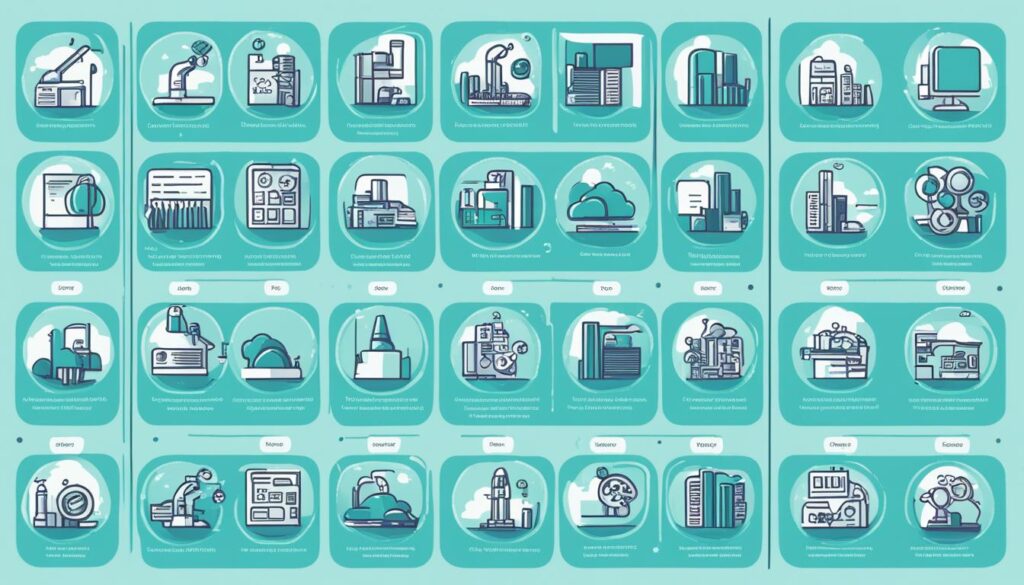Machine learning (ML) is part of both artificial intelligence (AI) and computer science fields. It’s about using data and algorithms for AI to learn in ways similar to humans. ML uses models that learn from data to make predictions or classifications.
Deep learning and neural networks, however, learn differently. They can deal with raw data and find features, while traditional machine learning needs manual help. There are three main types of ML models: supervised, unsupervised, and semi-supervised. Each type serves different purposes, from prediction to finding patterns.
The main benefits of machine learning include better predictions, recognizing patterns, and the ability to grow. Yet, it also has its downsides.
Key Takeaways:
- Machine learning is an AI branch that enables machines to learn like humans through data and algorithms.
- ML algorithms predict or classify based on data with a decision process and error checking.
- ML models fall into categories like supervised and unsupervised learning.
- These algorithms can analyze data, make future predictions, and find data trends.
- While machine learning offers many pros, there are also cons to think about.
Difference between Machine Learning and Traditional Programming
Machine learning and traditional programming tackle problems differently. They rely on distinct methods but share the common goal of using technology to find solutions.
Traditional Programming
Developers in traditional programming create code that outlines a task precisely. This code is built on knowledge to solve a problem directly. It’s strict, offering little room for change.
Traditional programming relies on a set of predefined rules that explicitly instruct the computer on how to solve a problem.
This method fits when problems are clear and rules are easy to set. It thrives in tasks with known solutions, using logic to reach answers.
Machine Learning
Machine learning works by learning patterns from data. It uses these patterns to predict or make decisions, without strict rules for each action.
Machine learning algorithms learn patterns and relationships from data examples to make predictions or decisions without explicit programming for each task.
The algorithms get better from the data they see. They can understand new data by what they previously learned, handling complex tasks efficiently.
Distinguishing Factors
What sets machine learning apart from traditional programming?
- Flexibility: ML can adjust and improve with new data, unlike traditional techniques that follow set rules.
- Automation: ML can make decisions by itself based on patterns learned, lessening the need for human-set rules for every situation.
- Complexity: It shines in managing intricate problems and vast arrays of data, unlike traditional methods that may fall short.
- Scalability: ML can handle large amounts of data swiftly and effectively, a challenge for manual programming.
Machine learning and traditional programming each have their place. And they can be used together to tackle challenges effectively, playing off each other’s strengths.
| Traditional Programming | Machine Learning |
|---|---|
| Explicit rules | Data-driven approach |
| Deterministic | Adaptable and flexible |
| Human intelligence | Pattern discovery and automation |
| Well-defined problems | Complex, non-linear problems |
This comparison table highlights the main contrasts between traditional programming and machine learning.
How Machine Learning Algorithms Work
Machine learning algorithms work through steps to predict or decide using data. Knowing this method is key to using machine learning effectively. Now, let’s look at the main steps.
Data Collection
The process starts with gathering data. The data’s quality and amount are very important for machine learning. More varied and accurate data makes the models better at guessing and deciding.
Data Preprocessing
Next, we need to clean the collected data before teaching our model. This includes fixing any missing info, spotting outliers, and removing stuff we don’t need. We then make sure all data is in the same format. This makes it easier to compare and helps our model work well. Also, we randomly split the data into two groups: one for training and the other for testing.
Model Selection
After cleaning our data, we pick a model that suits our problem. There are many models, like decision trees or neural networks, to choose from. The right one depends on what you’re trying to solve, the data you have, and what you want to find out. Each model has its own good and not-so-good points, so we must choose wisely.
Model Training
With a model selected, it’s time to train it. The model looks at the training data and tweaks itself to get better. It keeps adjusting its settings to match the real results as closely as possible. This is done using special algorithms designed to boost the model’s accuracy.
Evaluation and Fine-Tuning
Once the training is done, we check how well the model learned using the test data. We use different measures, like accuracy or error rates, to see how well it understands new data. Depending on these tests, we may tweak the model. This fine-tuning helps the model perform at its best.
Prediction or Decision Making
After fine-tuning, our model is all set to make choices or guesses on new data. It uses what it learned to find patterns and give us results from the input. This ability is what makes machine learning so powerful in automating choices and forecasting in different fields.

Understanding machine learning lets us make use of its deep predictive abilities. By following this approach, we can fully utilize data to make accurate predictions, automate decisions, and reveal new understandings.
Machine Learning Lifecycle
The process of a machine learning project goes through many important steps. These steps help in creating strong models with the power of machine learning. Organizations first understand the problem they aim to solve. Then, they gather and prepare the needed data. Next, they pick the right models, build and check them, and finally deploy these models.
But the journey doesn’t end there. Projects continue to be monitored and maintained. This keeps the models working well over time.
- Studying the problems: It all starts with understanding the problem well. Goals and aims are set for the model. The data sources needed to find the answers are then determined. And the main challenges to tackle are voiced out.
- Data collection and preparation: After understanding the problem, it’s time to gather data. Companies find and collect data from different sources. This data goes through a preprocessing stage. Here, it is cleaned and formatted right. Also, it’s split into parts for training and testing the models.
- Model selection: With the data ready, it’s time to pick a model. Choosing the right model is a key step. It must fit the problem and the data. Factors like problem type, data complexity, and the tech available need to be considered.
- Model building: The next step is building the selected model. This includes training it with the data. The model’s settings are adjusted to work best with the data available.
- Model evaluation: Once the model is built, it’s tested. The model is checked using the test data. Performance measures like accuracy and F1-score are looked at. These scores show how well the model is doing.
- Model tuning: If the model doesn’t perform well, it can be fine-tuned. This might involve changing settings or trying new methods. The aim is to make the model work better.
- Deployment: With a well-performing model, it’s time to put it in action. This is done in a real-life setting. It’s important to make sure the model fits in with existing systems smoothly.
- Monitoring and maintenance: Keeping an eye on the model is important. This helps in spotting issues early. Regular checks and updates ensure the model stays effective.
In the end, the machine learning lifecycle ensures that models are carefully developed and used. This approach helps organizations leverage machine learning for solving tough problems. It aids in making precise forecasts and smart data decision-making.
Types of Machine Learning
Machine learning is separated into different types, depending on how they learn. Each kind has benefits and tackles its unique set of issues.
Supervised Machine Learning
Supervised machine learning is about training algorithms with clearly labeled data. This allows them to correctly classify data or make predictions. It needs data with known outputs to steer the training. It does well in tasks such as image sorting, finding spam, and understanding feelings.
Unsupervised Machine Learning
Unsupervised learning works on data without clear labels, aiming to find patterns or groups. It doesn’t rely on known answers. Instead, it detects similarities and connections in the data. It’s good for tasks like figuring out customer groups, spotting unusual cases, and making recommendations.
Semi-Supervised Learning
Semi-supervised learning mingles supervised and unsupervised methods. It employs a bit of labeled data to make sense of a larger, unlabeled set. This makes it more efficient and can save time and money on labeling big datasets. It’s handy when lots of data is there but labeling it all would be too costly.
Reinforcement Machine Learning
Reinforcement learning is about a model learning by trying different things and seeing what works. It gets rewarded for good actions and penalized for bad ones. The aim is to learn how to get the most rewards. It’s frequently used in teaching robots, playing games, and solving optimization problems.
Each machine learning category has its strengths and uses. Knowing about them can help pick the best method for a particular problem.

Need for Machine Learning
Machine Learning helps businesses work smarter and offer bespoke services to customers. It uses complex algorithms to sift through big data. By doing this, it finds patterns and trends that humans might miss without much input from people.
It excels at tailoring experiences for customers as well. Machines learn and get better with more data, offering more precise recommendations. This not only makes customers happier but also strengthens the bond between them and the company.
Machine Learning also shines in tackling complex problems with ease. For instance, in healthcare, it can diagnose illnesses by spotting patterns in patient data. In finance, it’s great at catching fraud by detecting unusual patterns in transactions.
As time goes on, machine learning keeps getting better at handling more data. This means it can provide deeper insights for decision-making. It’s becoming a cornerstone for businesses aiming to be more efficient.
In summary, machine learning is a game changer. It excels in recognizing patterns, improving efficiency, and tailoring experiences. Businesses that embrace it can work more effectively, extract insights, and better serve their customers.
Various Applications of Machine Learning
Machine learning has greatly changed many industries. It is used in several important ways. Let’s look at some top fields where machine learning is very influential:
1. Image Recognition

Image recognition uses machine learning to spot and sort objects in pictures. It is used in self-driving cars, health care, and security. This tech helps these fields work better and safer.
2. Natural Language Processing (NLP)
Machine learning is behind natural language processing. This area makes language tasks, like talking, writing, and understanding, easier for computers. NLP builds things like chatbots and translation apps, which are super helpful.
3. Fraud Detection
Machine learning is key in spotting fraud. It looks for unusual patterns in transactions to stop fraud quickly. Many fields use this, like finance, online shopping, and keeping systems safe online.
4. Recommendation Systems
Recommendation systems use machine learning to suggest things based on what you like. They improve your shopping experience, help you find new songs, and connect with friends online. These algorithms are in many tech sites we use every day.
We’ve only just begun to see what machine learning can do. As tech grows, machine learning will keep changing how business is done. It offers lots of new paths for progress.
Limitations of Machine Learning
Machine learning is great but we need to know its limits. This includes issues with biased data, hard-to-understand models, keeping data private, and the need for lots of computer power.
Reliance on Data
Machine learning needs good data to work well. If the data is biased, the conclusions can be too. This can keep unfairness going. It’s important to watch for and fix these biases.
Interpretability Challenges
Understanding complex machine learning models is tough. This is especially true for deep learning. But, in some areas like healthcare, we need to be able to trust and follow the model’s decisions.
Data Privacy Concerns
To learn well, machine learning needs a lot of data. But, this can go against people’s privacy. It’s key for organizations to respect privacy laws and make sure data is safe.
Computational Requirements
Big machine learning models need a lot of computer power. This means strong hardware and infrastructure. Lots of resources are needed, particularly in big projects or when speed is crucial.
“Machine learning models can produce impressive results, but we should always consider their limitations and ethical implications. Addressing issues of biased data, interpretability, data privacy, and computational requirements is crucial for building robust and responsible machine learning systems.”
Overcoming machine learning challenges needs many experts together. Data specialists, ethicists, and more must work as a team. This is how we use machine learning responsibly and ethically.
| Limitations | Challenges |
|---|---|
| Reliance on Data | Biased data leading to biased predictions |
| Interpretability | Complex models difficult to explain and understand |
| Data Privacy | Concerns regarding privacy and protection of data |
| Computational Requirements | High computational resources and infrastructure |
Conclusion
Machine learning is changing the game in many industries. It helps make AI applications smarter. From recommending what you might like to driving cars without human help, it has had a big impact.
This technology is key in our advancing world. It brings many new positive changes. But we must also think about its limits and possible ethical issues, like using bad data or explaining how decisions are made.
Looking ahead, machine learning will shape our future tech in big ways. It can sift through tons of data, find trends, and predict things accurately. Keeping up with its progress and using it well are important for making our world better.
FAQ
What is machine learning?
Machine learning is part of artificial intelligence (AI) and computer science. It uses data and algorithms for AI to learn like humans. It trains algorithms on data to make predictions without specific rules.
What is the difference between machine learning and traditional programming?
Traditional programming sets specific rules for computers to follow. However, machine learning lets the computer learn from data examples to form its own models. By using datasets, it learns patterns to later apply to new data.
How do machine learning algorithms work?
Machine learning algorithms use data to predict or decide things. They go through steps like collecting and preparing data, picking a model, training it, checking how well it works, and applying it to new info.
What is the machine learning lifecycle?
The machine learning process starts by understanding a problem and getting the right data. Then, it selects a model and trains it. After checking the model’s performance, it’s tuned for better results. It ends with putting the model to work and watching over its performance.
What are the types of machine learning?
There are four major types of machine learning: supervised, unsupervised, semi-supervised, and reinforcement learning. Supervised learning teaches algorithms on labeled data, like in classification tasks. Unsupervised learning looks at unlabeled data to find hidden patterns. Semi-supervised combines labeled and unlabeled data. Reinforcement learning uses a reward system to find the best actions or policies.
What are the advantages of machine learning?
Machine learning can make accurate predictions and spot patterns humans might miss. It’s good at handling large data to find trends. This leads to new efficiencies in many fields.
What are the applications of machine learning?
Machine learning is everywhere today. It helps with image and speech recognition, fraud detection, and making product recommendations. It’s changing how we do things in different fields.
What are the limitations of machine learning?
Yet, machine learning is not perfect. It depends on the data, so biased data can cause biased decisions. Also, its models can be hard to understand, and privacy could be a problem. It often needs a lot of computing power too.
What is the impact of machine learning and AI in the future?
Looking ahead, machine learning and AI might greatly change our world for the better. Knowing the basics and ethics of machine learning is key. It can bring new efficiencies and chances in many areas.


















